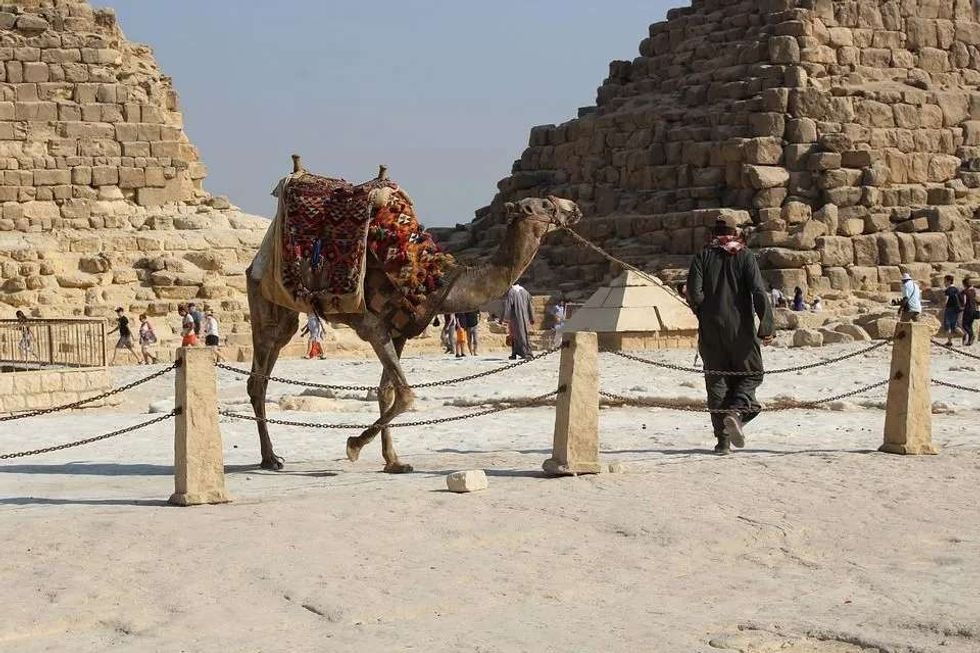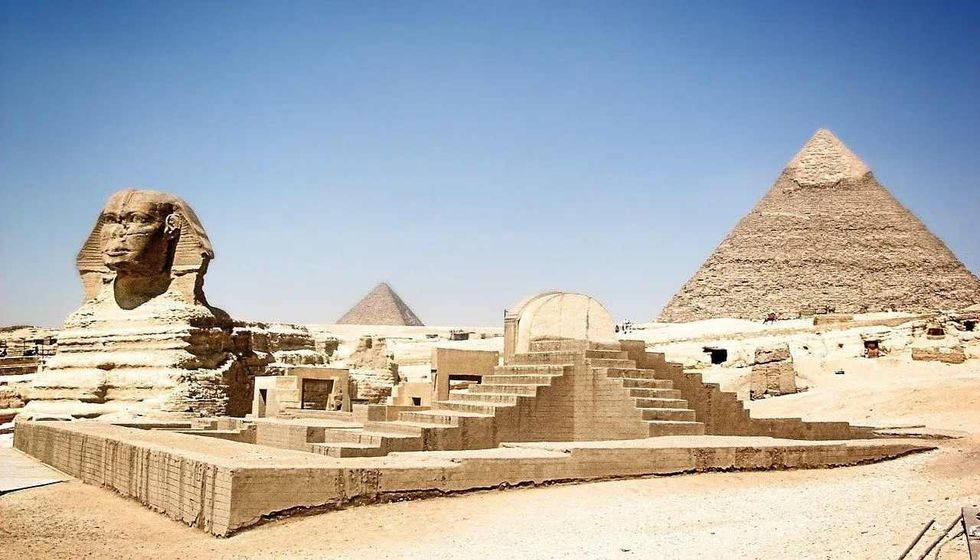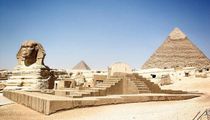73 Facts About Khufu That Give Details On Ancient Egyptian History

Often known by his Greek name, King Cheops, Khufu was the man behind the building of the Great Pyramid!
One of the most fascinating things about this pharaoh is that not much information is available about him in the form of sculptures except for the Khufu Statuette! King Khufu has been a part of the conversations that run in learned circles for a long time.
Considering the fact that he ordered the making of one of the most important and best-preserved ancient wonders of the world, the desire to know more about this ancient Egyptian emperor is but legitimate. However, Khufu's reign remains largely unexplained except for the few statues and temples that have been recovered on several occasions.
Historians, old and new, have been trying to understand the man behind one of the most famous destinations of the world, which has led them to the discovery of certain facts.
You might have also heard of King Khufu under different names. The Greeks referred to him as 'Cheops', while he is referred to as 'Suphis' in still other places.
Whether it is his Greek name or Egyptian title that you have heard, the fact remains that King Khufu was one of the most influential kings of ancient Egypt and his rule was crucial towards the building of the empire into an indomitable force. Keep reading to know more facts about King Khufu!
The Life History of Khufu
The ancient Egyptian Pharaoh, Khufu, is known as one of the most important rulers of Egypt. His rule can be linked with several important events as well as monuments.
King Khufu and his life have been a matter of deep interest for historians as well as archaeologists over the past few centuries, which is obvious given the amount of information that his monuments and temples can give us about ancient Egyptian civilization and the tendencies of the rulers.
- The most important of these contributions that King Khufu made was the construction of the Great Pyramid of Giza.
- This pyramid stands largely unaffected to the day and is a testament to the ancient Egyptian skills in terms of architecture. The Great Pyramid of Giza now stands as one of the most important ancient structures.
- The pyramid was so high and grand that it becomes extremely difficult for us to believe that the Fourth Dynasty of ancient Egypt would have been capable of such engineering marvels.
- One of the most fascinating things about Pharaoh Khufu is that in spite of how important his rule was, there is no evidence or record of the birth of this king.
- Unfortunately, the Great Pyramid at Giza and the accounts by ancient Egyptians do not throw much light on King Khufu's life and persona.
- The Pharaoh Khufu is little known in terms of his persona, his birth, his time on the throne, and many other things.
- To add to the mystery that seems to be an intrinsic part of this Pharaoh, the Great Pyramid did not actually have Khufu's mummy in it!
- Whether or not the Great Pyramid was a decoy and was intended towards misleading people so that the real mummy of the king is not known, we do know that the finding of Khufu's mummy would be ground-breaking.
- King Khufu's birth mother was Queen Hetepheres, who married King Snefru.
- King Snefru was also the founder of the Fourth Dynasty of ancient Egyptian society, which essentially meant that King Khufu was the second king or Pharaoh.
- King Khufu succeeded to the throne during his 20s, most probably at the age of 23, and immediately started work towards the Great Pyramid that we now see at Giza.
- He even employed one of his nephews, Hemiunu, to design the mammoth that the Great Pyramid is!
- One of the lesser-known facts about King Khufu is that he was born as Khnum Khufu and not just 'Khufu'!
- Khufu's pyramid consists of three main compartments, the largest of which was supposedly intended for his own mummy.
- Whether or not the mummy was stolen and taken as loot is a matter of speculation and there isn't enough evidence on either side of the argument.
- The King's chamber in the pyramid is large, and cannot be bested by the other two.
- One of the other two chambers was supposedly made for King Khufu's main wife, Queen Meritites.
- Khufu got married to several women during his time and fathered no less than nine sons.
- He also had 15 daughters. Not much is known about the courses that their lives took later on.
- Khufu's heir was Prince Kawab, who was supposedly murdered by one of his half brothers in greed for the throne.
- Khufu, the second king of the Fourth Dynasty, was therefore succeeded by Prince Djedefre, who was the same half-brother who supposedly killed Prince Kawab.
- His reign was short and was succeeded by Prince Khafre.
- We do however know that he strove towards making sure that the bloodline of the royal family remained pious. This was one of the reasons why he got married several times and to many of his half-sisters.
- There is not much drama around the death of this ancient, mysterious Pharaoh. Historians assume that he died of natural causes.
- While some ancient historians seem to be of the opinion that King Khufu ruled for well over 60 years, modern historians estimate that his rule would have spanned for around 24-26 years. However, the exact numbers cannot be specified until the proof has been unearthed.
- The Pyramid of Khufu is in the Giza complex along with other pyramids.
Nicknames Of Khufu
What comes with the analysis of a king's rule by historians all around the world is a difference of information.
While there are fewer discrepancies with regards to the information that we have been able to find about King Khufu, there seems to be a lot of difference in terms of the names that have been used to refer to this ancient Egyptian Pharaoh.
- The real name of King Khufu was Khnum Khufu.
- This roughly translates to 'Khnum protects me'.
- Khnum was the Earth deity who was held in high esteem in ancient Egyptian society.
- Khnum was the god of fertility and looked over River Nile.
- The Greeks referred to Khufu as King Cheops.
- The other names that Pharaoh Khufu was known by were Suphis, Sofe, and Chnoubis.

Details Of Khufu's Family
The family trees of several ancient Egyptian Pharaohs are riddled with several marriages. Some of these marriages even stand against the values garnered by the society that we now live in.
However, it is important to understand that at that time in the history of Egypt, having your bloodline unadulterated by other families was essential to maintaining a good grip over the throne.
- King Khufu, too, got married several times and most of his marriages were within the family.
- Kings at this time would marry their own half-sisters or cousins in order to make sure that the bloodline was sacred. It does seem absurd to us now but this was the practice of thousands of years ago!
- Pharaoh Khufu was the second king of the fourth dynasty of ancient Egypt.
- Khufu succeeded his father, King Snefru.
- There seems to be some confusion in the learned circles and amongst the famous historians of the world regarding whether or not King Snefru really was King Khufu's father.
- However, we have much more solid evidence of King Khufu's mother. Khufu was the son of Queen Hetepheres, who married King Snefru later in her life.
- Some historians seem to be of the opinion that Queen Hetepheres married King Snefru in what might have been a second marriage-like situation.
- His speculated father, King Snefru, was the founder of the fourth dynasty of Ancient Egypt, which essentially makes King Khufu the second pharaoh!
- King Khufu went on to marry several times, which was a common practice in Ancient Egypt in order to make sure that the king never ran out of heirs to the throne.
- Records say that King Khufu was blessed with a total of nine sons and 15 daughters from his many wives.
- King Khufu's principal wife was Queen Meritites, which was presumably also the title that Queen Hetepheres enjoyed before her.
- Queen Meritites gave birth to Pharaoh Khufu's heir, who was named Prince Kawab.
- Kawab, unfortunately, died or was murdered during his father's reign.
- The throne changed hands from Prince Djedefre to Prince Khafre.
- It is said that Prince Kawab was killed by one of his half-brothers!
- One of the rather interesting facts about King Khufu is that his main wife, Queen Meritites, was in fact his half-sister.
- The same relation was there between the Pharaoh and his wives before they got married.
- This shows the extent to which ancient Pharaohs would go in order to maintain the purity of their bloodline and to also keep the riches within the family!
- Since Prince Kawab had already died, the throne went to Djedefre first, and then to Khafre.
- Some ancient historians believe that King Khufu and King Khafre's time was one of the worst in the history of Ancient Egypt.
- However, it is also important to note that most modern historians reject such ideas and claim that they have been based on no solid proof.
- These claims made by the ancient historians do not seem to make sense as there are no real relics from the Old Kingdom that seem to validate the views of the ancient historians of the likes of Herodotus.
- Most of King Khufu's children are believed to have held influential positions at court, which was a common practice in Ancient Egypt. This was because people seemed to practice nepotism.
- The same nepotism proved to be a curse, as two of Khufu's children were murdered by their half-brothers in order to get the throne!
What did Khufu contribute as Pharaoh in Ancient Egypt?
King Khufu seems to have held as much of an important position in the hearts of the ancient Egyptians as the modern historians that now strive to learn about his rule.
In spite of the fact that the Great Pyramid and the temple ruins do not reveal much about King Khufu's rule, we can hardly deny the fact that his reign was a crucial time in the history of the fourth dynasty of Ancient Egypt.
- While there are some speculations that King Khufu might not have been the most kind-hearted and merciful king of the world at the time, we can always choose to face the light whilst stronger and more consequential proof is being unearthed by archaeologists!
- Each historian seems to have their own rendition of Pharaoh Khufu's rule over Egypt, which is understandable given the sheer lack of information and records that we currently have regarding this king.
- An ancient Greek historian named Herodotus seems to be of the opinion that Pharaoh Khufu was an absolute terror and that he did not pay attention to his people at all.
- Herodotus was also of the opinion that Khufu and his sons' rule was absolutely disastrous and that he handled all matters rather oppressively.
- Herodotus and other historians of his time also seem to be of the opinion that the Giza pyramids were built by people who were taken slaves by the king and king's men.
- However, with more extensive research and studies, modern historians seem to be quite against such claims. It is in the view of modern historians that Khufu was as sensible as a leader as he was in the process of making such a marvelous monument that would stand as a magical wonder for thousands of years.
- In addition to Khufu's pyramid, there are other things that seem to make sure that the king's rule is not made to sound notorious.
- Pharaoh Khufu is also known for causing a slow but major shift in the religious sensibilities of society.
- At this time, the ancient Egyptian society saw a shift from being centered around the Earth God called Khnum, but slowly it moved towards the worship of the Sun-god named Ra. It became popular in the Fifth Dynasty.
- Through this, Pharaoh Khufu was also able to establish himself as a mediator between the gods and the people of his kingdom.
- He started the construction of the Great Pyramid of Giza right when he came to the throne.
- This was at a time when he was nearly 23 years old, which shows the king's artistic sensibilities and vision.
- He is also credited with the building of the Solar Boat which was found inside the Great pyramid.
- This boat is now at the Grand Egyptian Museum and can be viewed freely.
- One of the greatest things about this boat is the fact that if we were to use it today, it would still hold out into the sea!
- In addition to giving us one of the Seven Wonders of the World, King Khufu has also featured in some of the most famous video games such as Tomb Raider and Assassin's Creed.
- He is also known to have sent expeditions for finding turquoise stones, asbestos, and copper!
We Want Your Photos!
More for You
Bachelor of Arts specializing in English Language and Literature

Shirin BiswasBachelor of Arts specializing in English Language and Literature
With a degree in English from Amity University, Noida, Shirin has won awards for oratory, acting, and creative writing. She has a wealth of experience as an English teacher, editor, and writer, having previously worked at Quizzy and Big Books Publishing. Her expertise lies in editing study guides for children and creating engaging content.
Master of Arts specializing in History

Sudeshna NagMaster of Arts specializing in History
Having earned a Master's degree in History from the Presidency University in Kolkata, Sudeshna was able to refine these skills and broaden her knowledge base. Not only is she an accomplished fact-checker, but she is also deeply invested in gender research, societal interactions, and mental health. Her professional repertoire also includes experience in translation between Bengali and English content
Disclaimer
1) Kidadl is independent and to make our service free to you the reader we are supported by advertising. We hope you love our recommendations for products and services! What we suggest is selected independently by the Kidadl team. If you purchase using the Buy Now button we may earn a small commission. This does not influence our choices. Prices are correct and items are available at the time the article was published but we cannot guarantee that on the time of reading. Please note that Kidadl is a participant in the Amazon Services LLC Associates Program, an affiliate advertising program designed to provide a means for sites to earn advertising fees by advertising and linking to Amazon. We also link to other websites, but are not responsible for their content.
2) At Kidadl, we strive to recommend the very best activities and events. We will always aim to give you accurate information at the date of publication - however, information does change, so it’s important you do your own research, double-check and make the decision that is right for your family. We recognise that not all activities and ideas are appropriate for all children and families or in all circumstances. Our recommended activities are based on age but these are a guide. We recommend that these ideas are used as inspiration, that ideas are undertaken with appropriate adult supervision, and that each adult uses their own discretion and knowledge of their children to consider the safety and suitability. Kidadl cannot accept liability for the execution of these ideas, and parental supervision is advised at all times, as safety is paramount. Anyone using the information provided by Kidadl does so at their own risk and we can not accept liability if things go wrong.
3) Because we are an educational resource, we have quotes and facts about a range of historical and modern figures. We do not endorse the actions of or rhetoric of all the people included in these collections, but we think they are important for growing minds to learn about under the guidance of parents or guardians.







